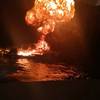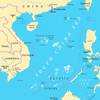US Reaffirms 'Ironclad' Commitment to Philippines Defense
U.S. Defense Secretary Pete Hegseth reaffirmed the United States' unwavering commitment to its decades-old defense treaty with the Philippines during a visit to Manila on Friday, pledging to bolster the alliance with advanced military capabilities in the face of increasing tensions with China.
Meeting with Philippine Defense Secretary Gilberto Teodoro and President Ferdinand Marcos Jr., Hegseth underscored Washington’s support for its Indo-Pacific ally, particularly as Manila continues to accuse Beijing of aggressive behavior in the South China Sea.
“Deterrence is necessary around the world, but specifically in this region, in your country, considering the threats from the communist Chinese,” Hegseth said during a joint press conference with Teodoro. He emphasized that while the U.S. is not seeking conflict, it is committed to peace through strength, describing former President Donald Trump as a “peacemaker.”
“President Trump seeks peace ... but in order to bring that peace, we will be strong,” he said. “Our allies will know we stand with them. Our admirals are prepared, and they will be properly equipped. We're rebuilding our military under President Trump.”
Beijing, in turn, pushed back strongly against the remarks. Chinese Foreign Ministry spokesperson Guo Jiakun accused Washington of stoking ideological tensions and provoking instability in the region. “All along, it is the U.S. that has been indulging its allies in provocations in the South China Sea,” Guo said at a press briefing. He called on the Philippines not to act in coordination with the U.S. in ways that might escalate military tensions.
China claims vast areas of the South China Sea as its territory—claims that overlap with the exclusive economic zones of several Southeast Asian countries, including the Philippines, Vietnam, Malaysia, Brunei, and Indonesia.
The Philippines is the first stop on Hegseth’s Asia tour, which has been overshadowed by a controversy involving leaked sensitive U.S. military plans related to Houthi targets in Yemen. The plans were reportedly shared via a commercial messaging app that included a journalist. When asked about the incident, Hegseth did not comment directly but said his focus was ensuring the U.S. defense establishment remained ready and prepared.
As part of its enhanced military cooperation, the U.S. will deploy advanced defense systems to the Philippines, including the NMESIS anti-ship missile system and unmanned surface vessels. The two nations have also agreed to conduct joint special forces exercises in Batanes, the Philippines’ northernmost province, located near Taiwan.
“Our partnership not only continues today, but we are doubling down on that partnership,” Hegseth said. “Our ironclad alliance has never been stronger.”
President Marcos welcomed the deepening ties, calling Hegseth’s visit a strong signal of the two countries’ shared resolve to maintain regional peace.
“It sends a very strong message of the commitment of both our countries to continue to work together to maintain the peace in the Indo-Pacific region within the South China Sea,” he said.
Hegseth’s visit coincided with trilateral maritime drills in the South China Sea involving the U.S., Japan, and the Philippines. The exercises featured Japan’s frigate JS Noshiro, the Philippine Navy’s BRP Jose Rizal, and the U.S. Navy’s guided-missile destroyer USS Shoup—the eighth round of such coordinated exercises among the allies.
The defense secretary is scheduled to travel to Japan next, where he will meet with Japanese Defense Minister Gen Nakatani and Prime Minister Shigeru Ishiba to reinforce trilateral security cooperation across the Indo-Pacific.
“We’re here in the Philippines to strengthen that partnership. We’ll be in Japan to do the same,” Hegseth said.
(Reuters)















